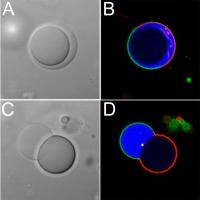
The model cell developed in the lab of Christine D. Keating at Penn State uses as the cytoplasm a solution of two different polymers, PEG and dextran (Panel A). The image in Panel B is the image in Panel A highlighted with fluorescent dyes. The blue region is PEG, which is concentrated in the outer polymer solution; the green area is the portion of the membrane that contains PEG groups, which interact with the contents of the cell; and the red area is the portion of the membrane with fewer PEG groups, which interact with the contents of the cell to a lesser extent. After exposure to a concentrated solution of sugar, the cell converted to a budded form (Panel C). A dextran-rich mixture filled the bud, while a PEG-rich mixture remained inside the body of the cell. Panel D shows the image in Panel C highlighted with fluorescent dyes. The blue area is the PEG-rich region. This new structure exhibits polarity both in the membrane and in the aqueous interior of the model cell. A team of Penn State researchers has developed a simple artificial cell with which to investigate the organization and function of two of the most basic cell components: the cell membrane and the cytoplasm--the gelatinous fluid that surrounds the structures in living cells. The work could lead to the creation of new drugs that take advantage of properties of cell organization to prevent the development of diseases. The team's findings will be published later this month (late May 2008) in the Journal of the American Chemical Society.
"Many scientists are trying to understand cells by turning off genes, one at a time, and are observing the effects on cell function, but we're doing the opposite," said Associate Professor of Chemistry Christine D. Keating, who led the research. "We're starting from scratch, adding in components to find out what is needed to simulate the most basic cell functions. Our goal is to find out how much complexity can be observed in very simple collections of molecules."
Building on previous work that was published in the 16 January 2008 issue of Journal of the American Chemical Society, Keating and her colleagues built a model cell using as the cytoplasm a solution of two different polymers: polyethyleneglycol (PEG) and dextran. The researchers encapsulated this polymer solution inside a cell membrane and, because the two polymers do not mix, one of the phases surrounded the other like the white of an egg around a yolk. The team then exposed the cell to a concentrated solution of sugar. Through a process known as osmosis--in which water diffuses across a cell membrane from a region of higher water concentration to a region of lower water concentration--water traveled from the relatively diluted polymer solution inside the cell to the more concentrated sugar solution outside the cell. As a result, the volume of the polymer solution inside the membrane was reduced.
With a cell membrane that was now too large and also unconstrained by its spherical shape, the cell converted to a budded form. A dextran-rich mixture filled the bud while a PEG-rich mixture remained inside the body of the cell. This new structure exhibited the type of complexity that the team had been looking for; it exhibited polarity. "Polarity is critical to development," said Keating. "It is an important first step in the development of a complex multi-cellular organism, like a human being, in which different cells perform different functions."
In previous work, the team created a membrane that was entirely uniform, but in their most recent paper, they describe an asymmetric membrane containing a mixture of lipid molecules. Some of these lipid molecules contained tiny pieces of PEG, which interacted with the PEG in the cytoplasm, thus generating polarity in the model cell. "Our work demonstrated the interrelationship of the cytoplasm and the cell membrane," said Keating.
The team's next step is to create a cascade in polarity. "By creating a model cytoplasm with different compositions, we demonstrated that we can control the behavior of cell membranes," said Keating. "Now we want to find out what will happen if, for example, we add an enzyme whose activity depends on the compositions of the cytoplasm and cell membrane."
Although Keating and her colleagues plan to continue adding components to their model cell, they don't expect to make a real cell. "We aren't trying to generate life here. Rather, we want to understand the physical principles that govern biological systems," said Keating. "For me the big picture is trying to understand how the staggering complexity observed in biological systems might have arisen from seemingly simple chemical and physical principles."
Source : Penn State
 Print Article
Print Article Mail to a Friend
Mail to a Friend
